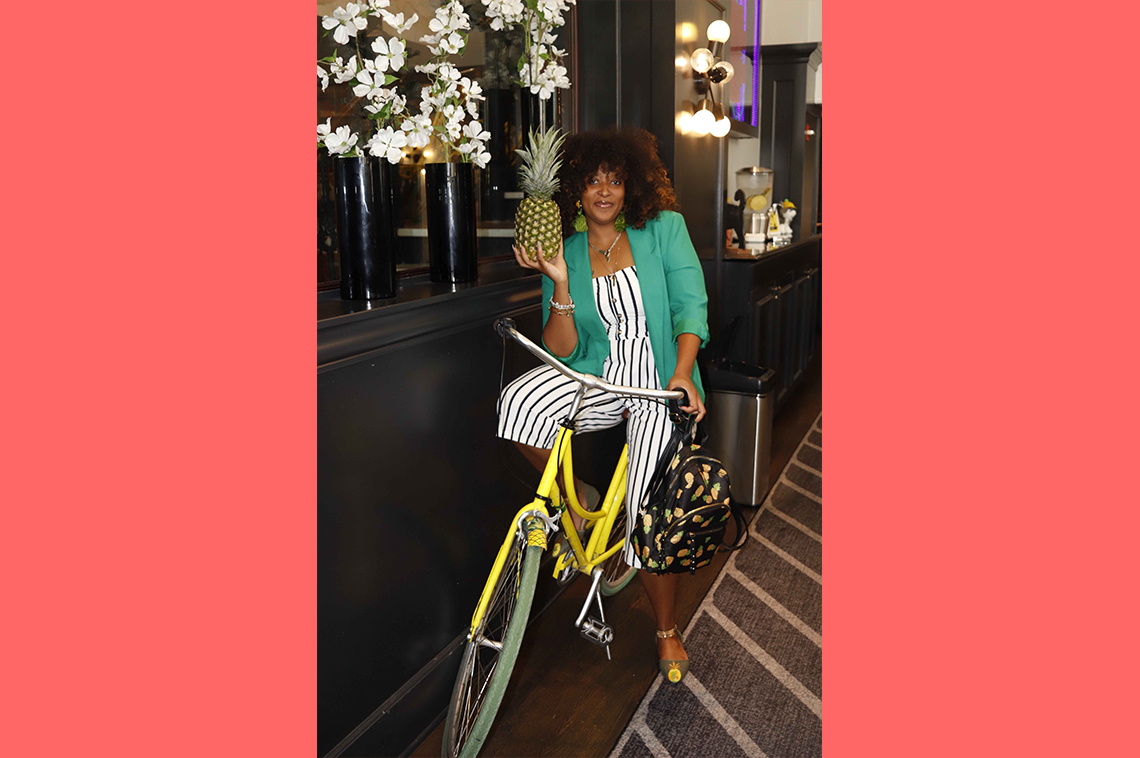
I’m April Fitzpatrick, a native of Jackson, MS, visual artist, art therapist, and founder and CEO of Pineapples with Purpose, LLC. I provide Black communities that have limited or no mental and emotional wellness resources with accessible art techniques to tell their stories and support their wellness. I journeyed through psychology, art therapy, and the mental health field realizing that my decade of exploration very seldomly included narratives that I could connect with as a Black child, Black student, Black researcher, Black woman, or Black artist. I grew restless constantly hearing language and theories rooted in Eurocentric values, which tended to see Black people through a deficient lens. When I would mention racism, the room grew still. How could we ever expect Black people to trust and be open to therapy that did not hold safe spaces for Black narratives to be told? How could I use my role as a Black artist and art therapist to address this never ending issue? I wanted to do things differently, by taking a non traditional approach - inviting and centering the voices of the community by intentionally increasing the use of art and symbolism to access the core of trauma.
Make Room for Your Crown
Talking about any level of mental health challenges is difficult, and digging into traumas of the past can be intimidating, uncomfortable, and embarrassing. My work transforms pain into passion using facts about a particular fruit- the pineapple; as it relates to the Black experience. In 1853, the pineapple traveled the same Transatlantic slave route as the first slaves arriving to South Carolina. The pineapple, meaning excellent fruit, became a luxury item because of its rarity, showcasing status for slave owners and soon becoming the symbol of hospitality. However, in this case and countless others, the Black experience was not welcomed. Because of my love for the fruit, I wanted to reimagine what it could mean for my own story to be told. I wanted to make room for my crown.
Addressing Trauma
The pineapple is central to my work in addressing trauma within the Black community. Challenging old perspectives, the fruit’s vibrancy urges viewers to create a new memory; that of the pineapple, a positive memory not bound by trauma. I want my audience to see my use of symbolism as a way to capture a snapshot of their own individual trauma and marry it with healing. Using the pineapple’s own growth and journey as a guiding metaphor, I dissect the fruit into three components-cradle, core, and crown-to consider the impact of cultural history, personal narratives, and community on sustaining mental and emotional wellness. Through my vision and use of the pineapple, I imagine getting to the “core” and my dual role as an artist and art therapist is the bridge that leads to that first step.
We Are our Memories
Known as the collective fruit, the pineapple is made of 200 flowers fused together to form one berry. Though memory is not perfect, collectively, it influences our perception in turn impacting our emotions, which results in voluntary or involuntary behaviors. Our collective memories have been racialized. Our collective memories have been silenced. We have been forced to re-grieve physical, mental, emotional, and spiritual violence while enduring inequities and injustices as a result of racism. We have become trapped in racial trauma that permeates through our bodies and affects our social and emotional functioning.
I use the collective nature of the pineapple to help us reframe our memories, reclaim our narrative and tell our story our way. Join me in reimagining the pineapple as a community collective where we are the flowers. The imagination turns a potential hard conversation about racism and mental health into a digestible topic. Creating a new memory that sticks, the pineapple becomes a consistent symbol for equilibrium; combating the foundation of trauma. Like signifiers that constantly remind us of our racial past, I hope the pineapple is the ultimate signifier, leading us to release and externalize trauma; giving this nightmare called ‘life in a racialized society’ a new story. I mean come on you can't help but smile when you look at a pineapple right?
What’s Next
My work is a building block and extension of me. I am working to reshape how we deliver information and engage with others regarding mental health in the Black community. I envision the literal meaning of “meeting people where they are” through a creative collective experience of artmaking. Currently, I am seeking funding and community partners to support the pineapple moving from theory to practice.
The goal is to cultivate a mobile space that welcomes and creates opportunities for communities affected by racial trauma and injustice to experience therapy in a new way. One that honors the values that have sustained so many Black communities across the nation in a way that leaves them feeling heard and provides a new symbol of healing on their worst day. Through creative expression, we can expel the grief so many of us are holding and manifest joy. The collective reimagining of symbolism will assist in the sustainability of our community. I open my gift as an offering just as each flower offers to the larger pineapple.
. . .
About April
With a background in psychology, an unconventional experience in art therapy, and commitment to visual artistry, April Fitzpatrick has given much attention to the mental health crisis in Black communities affording her the opportunity to see trauma from several perspectives. April holds a B.A. in Psychology from Tougaloo College, an M.S. in Art Therapy from Florida State University, and is a gallery recognized self-taught visual artist. She currently heads the first art therapy program that serves the Big Bend in Tallahassee, FL. Harnessing her knowledge and skills in creative execution, relationship building, community connection, and innovation, April brings the pineapple to the table to explore our inner core.





